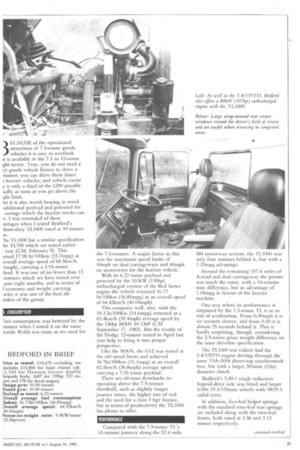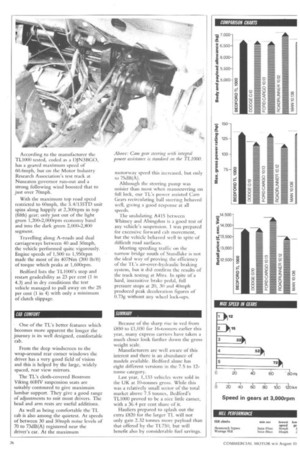A BIGGER TL
Page 26

Page 27

Page 28

If you've noticed an error in this article please click here to report it so we can fix it.
TO BEAT THE 7.5-TONNERS
If operators are prepared to forgo the tax, maximum permitted speeds and driving licence concessions which have made 7.5-tonners popular, they will find that there can be advantages in going one step up the weight scale.
3 ECAUSE of the operational attractions of 7.5-tonne goods vehicles it is easy to overlook It is available in the 7.5 to 12-tonne ght sector. True, you do not need a vy goods vehicle licence to drive a tonner; you can drive them faster i heavier vehicles; and vehicle excise y is only a third of the £290 payable ually as soon as you go above the ght limit.
;ut it is also worth bearing in mind additional payload and potential for savings which the heavier trucks can T. I was reminded of these antages when I tested Bedford's iium-duty TL1000 rated at 10 tonnes
SS.
'he TL1000 has a similar specification the TL750 which we tested earlier , year (CM, February 9). This imed 17.98 lit/I0Okm (15.7mpg) at averall average speed of 68.5km/h .6mph), carrying a 3.91-tonne 'load. It was one of no fewer than 13 -tonners which we have tested over past eight months, and in terms of I economy and weight carrying acity it was one of the best alltnders of the group.
CONSIIMPRON uel consumption was bettered by the -tonner when I tested it on the same )-mile Welsh test route as we used for the 7.5-tonners. A major factor in this was the maximum speed limits of 50mph on dual carriageways and 60mph on motorways for the heavier vehicle.
With its 6.23 tonne payload and powered by the 101kW (135hp) turbocharged version of the Red Series engine the vehicle returned 16.77 lit/100km (16.85mpg) at an overall speed of 64.42km/11 (40.04mph).
This compares well, also, with the 19.3 lit/100km (14.6mpg) returned at a 63.4km/h (39.4mph) average speed by the 136hp MAN 10.136F (CM September 17, 1983). But the results of the Dodge 12-tonner tested in April last year help to bring it into proper perspective.
Like the MAN, the G12 was tested at the old speed limits and achieved 18.71it/100km (15.1mpg) at an overall 62.5km/h (38.8mph) average speed carrying a 7_95 tonne payload.
There are obvious drawbacks to operating above the 7.5-tonnes threshold, such as slightly longer journey times, the higher rate of ved and the need for a class 3 hgv licence, but in terms of productivity the TL1000 has plenty to offer.
PERFORMANCE Compared with the 7.5-tonne TL's 51-minute journey along the 52.6 mile M4 motorway section, the TL1000 was only four minutes behind it, but with a 1.33mpg advantage.
Around the remaining 157.6 miles of A-road and dual carriageway the picture was much the same, with a 15-minute time difference, but an advantage of 1.08mpg in favour of the heavier machine.
One area where its performance is surpassed by the 7.5-tonne TL is in its rate of acceleration. From 0-30niph it is six seconds slower, and from 0-50 it is almost 25 seconds behind it. This is hardly surprising, though, considering the 2.5-tonne gross weight difference on the same driveline specification.
The TL1000 test vehicle had the 5.4/135T1) engine driving through the same T5A-3054 direct-top synchromesh box, but with a larger 381min (15in) diameter clutch.
Bedford's 189:1 single reduction hypoid-drive 'axle was fitted and larger 6.00x 19.5/135mm wheels with 9R19.5 radial tyres.
In addition, five-leaf helper springs with the standard nine-leaf rear springs arc included along with the two-leaf fronts, both rated at 3.56 and 2.13 tonnes respectively. According to the manufacturer the TL1000 tested, coded as a 1)j1\138GO, has a geared maximum speed of 60.6mph, but on the Motor Industry Research Association's test track at Nuneaton governor run-out and a strong following wind boosted that to just over 70mph.
With the maximum top road speed restricted to 60mph, the 5.4/135TD unit spins along happily at 2,300rprn in top (fifth) gear; only just out of the light green 1,200-2,000rprn economy band and into the dark green 2,000-2,800 segment.
Travelling along A-roads and dual carriageways between 40 and 50mph, the vehicle performed quite vigorously. Engine speeds of 1,500 to 1,950rpm made the most of its 407Nm (300 lb/ft) of torque which peaks at 1,600rpm.
Bedford lists the TL1000's stop and restart gradeability as 23 per cent (1 in 4.3) and in dry conditions the test vehicle managed to pull away on the 25 per cent (1 in 4) with only a minimum of clutch slippage.
CAB COMFORT One of the TL's better features which becomes more apparent the longer the journey is its well designed, comfortable cab.
From the deep windscreen to the wrap-around rear corner windows the driver has a very good field of vision and this is helped by the large, widely spaced, rear view mirrors.
The TL's cloth-covered Bostrom Viking 60HV suspension seats are suitably contoured to give maximum lumbar support. They give a good range of adjustments to suit most drivers. The head and arm rests are useful additions.
As well as being comfortable the TL cab is also among the quietest. At speeds of between 30 and 50mph noise levels of 70 to 73dB(A) registered near the driver's ear. At the maximum
motorway speed this increased, but only to 75dB(A).
Although the steering pump was noisier than most when manoeuvring on full lock, our TL's power assisted Cam Gears recirculating ball steering behaved well, giving a good response at all speeds.
The undulating A415 between Whitney and Abingdon is a good test of any vehicle's suspension. I was prepared for excessive forward cab movement, but the vehicle behaved well in spite of difficult road surfaces.
Meeting speeding traffic on the narrow bridge south of Standlake is not the ideal way of proving the efficiency of the TL's air-over-hydraulic braking system, but it did confirm the results of the track testing at Mira. In spite of a hard, insensitive brake pedal, full pressure stops at 20, 30 and 40mph produced peak deceleration figures of 0.73g without any wheel lock-ups.
SUMMARY Because of the sharp rise in ved from £850 to £1,030 for 16-tonners earlier this year, many express carriers have taken a much closer look further down the gross weight scale.
Manufacturers are well aware of this interest and there is an abundance of models available. Bedford alone has eight different versions in the 7.5 to 12tonne category.
Last year, 1,133 vehicles were sold in the UK at 10-tonnes gross. While this was a relatively small sector of the total market above 7.5 tonnes, Bedford's TL1000 proved to be a nice little earner, with a 36.4 per cent share of it.
Hauliers prepared to splash out the extra £820 for the larger TL will not only gain 2.32 tonnes more payload than that offered by the TL750, but will benefit also by considerable fuel savings.




































































